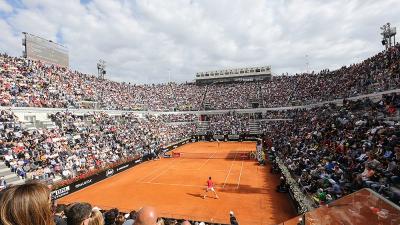Tennis: Italian Open bucks trend in declining attendance

ROME- The 2017 BNL Internazionali d’Italia, often referred to as the Italian Open, was a resounding financial success with a record number of spectators and proceeds for the Italian Tennis Federation. Whilst sports such as football and rugby are fighting the problem of declining attendence, tennis' popularity in Italy is on the rise. Unfortunately, the lack of quality in Italian tennis continues to mar the event, with no Italian tennis player making it past the second round.
A new high of over 220,000 paying spectators entered the gates of the Foro Italico in Rome, which added up to over 12 million euros in takings for the organisers from the ticket office alone. The tickets for the final were selling for at least 140 euros, with tennis fans willing to pay as much as 430 euros to watch Alexander Zverev beat Novak Djokovic in Sunday’s final. Increased ticket sales coupled with a lucrative television deal meant that this year’s edition brought in an estimated 30 million euros for the Italian Tennis Federation.
President of the federation, Angelo Binaghi, said in the traditional closing press conference that, “these figures represent the structural growth of the event.”
Whilst it is impossible to dispute the financial success of this year’s tournament, the future of Italian tennis on the court appears in dire straights, with the hopes of the nation perennially resting on the shoulders of the mercurial Fabio Fognini.
Fognini, to his credit, produced one of the performances of the tournament in beating Andy Murray on Tuesday evening, in front of a partisan home crowd desperately urging the Sanremo native onto victory. The match was a glimpse into the tournament’s potential were the home fans to have a genuine contender for the title. Sadly, the typically unpredictable Fognini rather ran out of gas in his second round defeat against eventual winner Zverev, and consequently the Italian tennis fans were left without a home player to support.
One must give credit to the Italian Tennis Federation for being one of the most independent sporting bodies in Italy, relying on just 12 percent of their overall funding from the state, with many Italian sporting federations being funded almost entirely by the government backed Italian Olympic Committee.
However, tennis is primarily a sport not a business and despite the success of the game off the court, the lack of an Italian presence on it is cause for concern. Fognini was the only Italian to make it past the first round this year, with Andreas Seppi and Gianluca Mager both failing in their opening outings in the mens draw. The women fared no better with Sara Errani, Roberta Vinci and Deborah Chiesa all crashing out in the first round. A string of poor results means that 16 of the last 18 games at the tournament involving an Italian have ended in defeat for the home favourite.
Binaghi has big plans for the future. The president wants to build a roof over the Campo Centrale to allow play to continue during a rain shower, increase the size of the Foro Italico area and even extend the duration of the tournament in a bid to be considered the unofficial ‘fifth major’ of the tennis calendar. None of these aspirations involve the improvement of grassroots tennis in Italy, and whilst programs are in place to increase youth participation in the sport, it certainly seems as if player development is very much a secondary agenda for the organisation. Failure to produce quality Italian tennis players means that the federation risks hosting a world class tournament without any Italian hopes of lifting the trophy.


